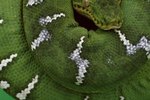
It is crucial to research the habits, biology and captive needs of your pet lizard; bearded dragons require different care than leopard geckos, for instance. While you must study things such as your pet's diet and temperament, understanding the natural habitat of your lizard is of paramount importance. Specifically, you must understand what type of climate and structural components your lizard needs, so you can recreate it.
Heating the Habitat
The most important aspect of setting up your lizard's habitat is establishing a thermal gradient -- one side of the cage should be warm, and the other side should be cool, with intermediate temperatures in between the two extremes. This allows your lizard to move from one side of the cage to the other in order to raise or lower his body temperature as needed. Sun-loving lizards -- for example bearded dragons (Pogona vitticeps), green iguanas (Iguana iguana) and chameleons (Chamaeleo ssp.) -- require heat lamps. You can heat subterranean and nocturnal lizards -- such as leopard geckos (Eublepharis macularius), tokay geckos (Gecko gecko) and night lizards (Xantusiidae) -- with ceramic heat emitters or heating pads instead, if you prefer. In all cases, place the heating element at one end of the cage. Use a digital thermometer to check the surface and air temperatures in all portions of the cage. It's important to research the needs of your specific pet to determine his preferred temperature range.
Solar Substitution
You must research your lizard's lighting needs, as the requirements vary greatly from species to species. In general, diurnal lizards that bask in the sun require lights that produce high quality light, including the UVB portion of the spectrum. Place these lights near the heat lamps to help simulate the sun. For nocturnal species, or those who inhabit the deep forest, quality lighting is important, but they usually do not require exposure to UVB. If you must provide UVB light for your lizard, be sure the lizard can get within 12 inches of the bulb, and that the light does not pass through glass or plastic, which will filter out the UVB rays. Use an automatic timer to keep the light levels consistent and match the photoperiod of his home range.
Suitable Substrates
The choice of substrate is dependent on both your pet's species and age. Fossorial species require a substrate suitable for digging, such as soil, sand or a custom blend. You can house terrestrial species on particulate substrates, such as -- depending on the species you keep -- orchid bark, cypress mulch or aspen. Alternatively, some keepers prefer to use sheet-like substrates, such as newspaper or paper towels. Regardless of the type of substrate you use, you must keep it clean. Particulate substrates may represent an impaction hazard, particularly for young animals, so care is warranted. Place your lizard's food in a dish to limit the chances that he will accidentally ingest substrate with his meal.
Furnishing Fundamentals
The type of furnishings necessary for your lizard vary with species as well. Chameleons require climbing branches, leopard geckos require rock crevices and frilled dragons need vertical tree trunks. Most nocturnal species require hiding locations, while animals like bearded dragons are often comfortable resting in the open. Many species appreciate a rock or branch placed under the basking lamp. Live and artificial plants help to create visual barriers and climbing opportunities for small lizards.
References
Photo Credits
-
Jupiterimages/Photos.com/Getty Images




